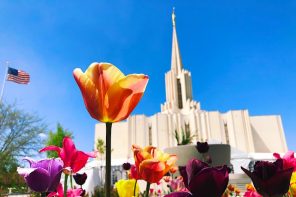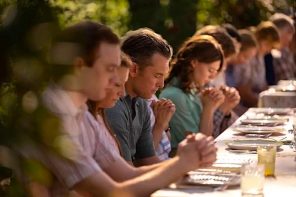Time magazine’s October 8 “The Mormon Identity” cover story on Mitt Romney (complete with an image of Romney as a stained glass window) brings the spotlight back to the candidate’s religion after a month of news cycles dominated by unfolding “catastrophes” in his campaign. And it’s no surprise, really. Where better to go than faith for a little warmth and inspiration in what has been a rather flat and grinding 2012 campaign?
The candidate may have done well to make faith a bigger part of his campaign storyline. Without question, his Mormonism is humanizing—it’s a deeply, originally American faith, successful against the odds, loveable in its quirks (as the South Park creators have convincingly shown), and replete with the kind of everyday magic religion should deliver. The fact that Romney has refused to tell that Mormon story about himself, aside from a few throwaway lines at the Republican National Convention delivered with a classic Romney please-don’t-punch me guardedness, has contributed immeasurably to his failure to connect with American voters. The language of shared differences is, after all, our national cultural currency.
This has left it to the press to talk about Romney’s religion, and coverage has improved markedly since 2008 and even since the early primary season. Many Mormons have been bracing for sensational exposes of sensitive aspects of Mormon belief and practice as an attack on Governor Romney—but that hasn’t happened. At least not yet. (Perhaps things would be different if the polls were closer.) Good journalists have also learned to look away from the Mormon fringes—White Horse prophecy, Cleon Skousenites—and toward its American corporate-bureaucratic culture to get a grip on the presidential candidate.
The way Time tells the story, Mormonism may yet save the day for Mitt Romney, providing him with sense of legacy, destiny, purpose, pragmatism, and determination. That’s a heroic narrative LDS people love as well, especially the many thousands who will fast and pray this Sunday for an unlikely Romney victory in next Wednesday’s first presidential debate.
But as the polls continue to slide, the more perceptive and compelling take on Romney’s Mormonism appears in this week’s New Yorker, where Nicholas Lemann depicts Mormonism and private equity (Romney’s home domains) as “a series of interconnected, tightly enclosed worlds, with their own rules” and a serious dose of “opacity.” That insularity and the closed-ranks hero worship it breeds are to me the key stories of the Romney campaign. Solving problems in small rooms with spreadsheets and PowerPoint presentations for self-selected audiences is, after all, a vastly different enterprise than the public arts of democracy. And living your life in those closed circles can lead not only to a general disdain for the people not in the room (cue the 47%) but also to stark disparities in the way a man views himself and the way he is viewed at large. As Lemann writes, Romney sees himself as a “rescuer,” “not a guy who used debt to buy and resell businesses.” Hard facts stand on the side of the latter.
The insularity, privacy, and opacity of Romney’s worlds and his guardedness are rooted, I believe, in the historic experience of LDS people as a historically persecuted American religious minority that continues to value its separateness from the “world.” To be a Mormon in the late 20th century was to witness the LDS Church’s phenomenal global growth and to believe that it happened not necessarily because the world was good and welcoming but because we were right. We were rescuers. But more complicated realities are emerging as our faith matures into the 21st century—including significant rates of disaffiliation among converts in Latin America and dropping rates of retention among our own young people. And there remain stark disparities between the way Mormons view ourselves and the way we are viewed beyond our own circles.
During his campaign, Romney could not tell the Mormon story in a way that connected with the experiences and values of other American communities. It will be up to the next generation of Mormon public figures to open the doors, step beyond the familiar circles, and do that humanizing work.




